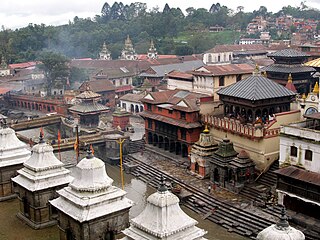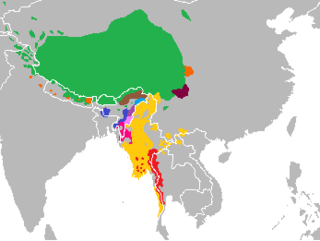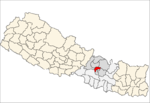The history of Nepal is intertwined with the history of the broader Indian subcontinent and the surrounding regions, comprising the areas of South Asia and East Asia.

Newar or Newari, also known as Nepal Bhasa, is a Sino-Tibetan language spoken by the Newar people, the indigenous inhabitants of Nepal Mandala, which consists of the Kathmandu Valley and surrounding regions in Nepal.

The Rai people are indigenous ethnolinguistic groups of the Indian subcontinent, what is now modern-day Nepal and present-day India, mainly in the Indian states of Sikkim and West Bengal. They were Rai meaning king (Rai means King in old Khas Kura. When the king Prithvi Narayan Shah couldn't defeat Khambu king, he somehow took them in confidence that the land is theirs forever and gave them the title Rai in around B.S. 1832. Then the post-Rai was provided to the topmost leaders of the region. They were given the power to collect land tax. That's why sometimes Rai people are called Jimee or Jimee-wal. The Rai belong to the Kirati group or the Kirat confederate Limbu, Sunuwar, Yakkha and Dhimal ethnic groups.

The Tamangཏ་མང are the largest Tibeto-Burman ethnic group within Nepal and traditionally Buddhist by religion. Constituting 5.6% of the national population at over 1.3 million in 2001, increasing to 1,539,830 as of 2011 census, yet contested. Tamangs are also a significant majority in Sikkim and Darjeeling District of West Bengal, India as permanent settlers; their languages are the fifth most spoken in Nepal. They are considered as one of the indigenous people of Nepal. Peculiar to Tamang people are complex marriage restrictions within the community.
Ranjitkar is one of the castes of Newar. The Newari caste system is divided according to profession. The Ranjitkar caste is concerned with the dyeing of clothes as well as other color related activities. The word "Ranjitkar" comes from Sanskrit origins crudely meaning "people concerned with colors" whereas the word "Chhipaa" is a Nepal Bhasa compound word which can be roughly translated as "color and allow to dry".

Buddhism in Nepal started spreading since the reign of Ashoka through Indian and Tibetan missionaries. The Kiratas were the first people in Nepal who embraced Gautama Buddha’s teachings, followed by the Licchavis and Newars. Buddha was born in Lumbini in the Shakya Kingdom. Lumbini is considered to lie in present-day Rupandehi district, Lumbini zone of Nepal. Buddhism is the second-largest religion in Nepal. According to 2011 census, the Buddhist population in Nepal is 9% of the country population. It has not been possible to assign with certainty the year in which Prince Siddhartha, the birth name of the Buddha, was born, it is usually placed at around 563 BCE. According to 2001 census, 10.74% of Nepal's population practice Buddhism, consisting mainly of Tibeto-Burman-speaking ethnicities, the Newar. In Nepal's hill and mountain regions Hinduism has absorbed Buddhist tenets to such an extent that in many cases they have shared deities as well as temples. For instance, the Muktinath Temple is sacred and a common house of worship for both Hindus and Buddhists.

Hinduism is the largest and has been considerd as state religion of Nepal due to call for protection of Sanatan Dharma I.e Hinduism. In the 2011 Nepal census, approximately 81.3 percent of the Nepalese people identified themselves as Hindus, although observers note that many of the people regarded as Hindus in the 1981 census could, with as much justification, be called Buddhists. According to 2011 census, the Hindu population in Nepal is estimated to be around 22.1 million which accounts 81.3% of country's population. The national calendar of Nepal, Vikram Samvat, is a solar Hindu calendar essentially the same to that widespread in North India as a religious calendar, and is based on Hindu units of time.

Gurung is spoken by the Gurung people. The total number of all Gurung speakers in Nepal was 227,918. There is no distinction between Gurung as an ethnic group and the number of people who speak the language.
The Kirāta (Kirat) is a generic term in Sanskrit literature for people who had territory in the mountains, particularly in the Himalayas and Northeast India and who are believed to have been Sino-Tibetan in origin. The Kiratas are Limbu, Rai, Yakkha, Sunuwar and Lepcha tribes of Eastern Nepal The Kiratas in Distant Past A Sanskrit-English Dictionary refer the meaning of 'Kirat' as a 'degraded, mountainous tribe, a savage and barbarian' while other scholars attribute more respectable meanings to this term and say that it denotes people with the lion's character, or mountain dwellers.

Federal Democratic Republic of Nepal is a multi-cultural, multi-ethnic, multi-lingual and multi-religious nation. Shiva has been regarded as guardian deity of Nepal. Nepal is the home to world famous lord Shiva pashupatinath temple where all Hindus globally visit the holy place for pilgrimage and it is also birth place of Goddess Sita and lord Buddha according to Hindu mythology. Nepal is a secular state and also it become Democratic country by 2008 according to it's constitution but "however Hinduism has been considered as State religion of Nepal due to labelling of Secularism in the constitution which clearly state's "Secularism in Nepal means protection of Sanatan Dharma I.e Hindu culture while ensuring cultural and religious freedom". Cow has been declared National animal of Nepal which is holy animal in Sanatan Dharma I.e Hinduism and government has ban cow slaughter and it is illegal by law. Freedom of religion is also guaranteed by Nepali constitution. Conversion to other religion is not allowed and it is illegal according to constitution because conversion of another religion is prohibited by law. Prior to the movement for democracy in early 2006 and the sacking of King Gyanendra in 2008, the country was officially a Hindu kingdom but still constitution uphold to protect and foster Hindu culture observed by Nepali Hindus. Hinduism is the majority religion in the state and profoundly influences its social structure and politics, while Buddhism is practiced by some ethnic groups in forms which are strongly influenced by Hinduism; Kiratism otherwise is the grassroots native religion of populations belonging to the Kirati ethnicity. Islam, Christianity, Sikhism and Jainism have made inroads and are the religious identity of small populations especially in eastern Nepal.
Khaling is a Kiranti language spoken in Solukhumbu district, Nepal and in India. It is one of the few Kiranti languages with tonal contrasts, which are of secondary origin.

Kusunda (Kusanda) is a language isolate spoken by a handful of people in western and central Nepal. It has only recently been described in any detail.
Vayu (वायु), Wayu or Hayu (हायु) is a Sino-Tibetan language spoken in Nepal by about 1740 people in the Janakpur Zone. Dialects include Sindhuli and Marin Khola.

Belbari, officially known as Belbari municipality, is one of the major suburbs of Morang district, Province No. 1.It lies in the eastern Terai region of Nepal. It was officially upgraded to become a municipality in 2014 AD, which is 2070 BS, which otherwise was a Village Development Committee (VDC) prior to that change. In order to meet the requirements to become a municipality, Belbari VDC merged Kaseni VDC with itself, making it larger in total area.Moreover,in 2017 AD VDC like Dangihat and Bahuni merged with it to become present Belbari Municipality.
Raji–Raute is a branch of the Sino-Tibetan language family that includes the three closely related languages, namely Raji, Raute, and Rawat. They are spoken by small hunter-gatherer communities in the Terai region of Nepal and in neighboring Uttarakhand, India.
Byangsi is a West Himalayish language of India and Nepal. Estimates of numbers of speakers vary, but some sources say that the language is spoken by about 1,000-1,500 people, while others estimate as many as 3,300. Byangsi is from a region of high language density, that is to say that there are many languages among few people. It is the most dominant language in Uttarakhand, although it is not widely known outside of its small hill district and those who speak it have difficulty classifying themselves for central government dealings.
Tsum is a language from the subgroup of Tibetic languages spoken by the Tsum people primarily in the Tsum valley of the Gorka District of Nepal. The language is also known as Tsumke.
Nepal, officially the Federal Democratic Republic of Nepal, is a landlocked sovereign state located in South Asia between two mighty countries; China at north and India at east, west and south. The national symbols of Nepal are:

Nepali, known by the endonym Khas Kura also known as Gorkhali or Parbatiya, is an Indo-Aryan language of the sub-branch of Eastern Pahari. It is the official language of Nepal and one of the official status-gained languages of India. It is spoken mainly in Nepal and by about a quarter of the population in Bhutan. In India, Nepali is listed in the Eighth Schedule to the Constitution as an Indian language, with official status in the state of Sikkim, and spoken in Northeast Indian states such as Assam and in West Bengal's Darjeeling district. It is also spoken in Burma and by the Nepali diaspora worldwide. Nepali developed in proximity to a number of Indo-Aryan languages, most notably the other Pahari languages and Maithili, and shows Sanskrit influence. However, owing to Nepal's location, it has also been influenced by Tibeto-Burman languages. Nepali is mainly differentiated from Central Pahari, both in grammar and vocabulary, by Tibeto-Burman idioms owing to close contact with this language group.

















